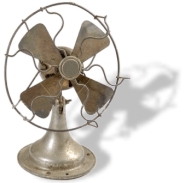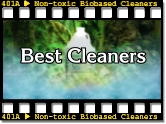
|
|
OVERVIEW
OF INDOOR AIR QUALITY ISSUES
–
What We Don’t Know but Should Know
about the Air We Breathe –
Part 4 -
Which Technology Works the Best?
|

E.
Which technology works best?
THAT something needs to be done is fairly obvious.
WHY people do what they do is evidenced by a recent
market survey response where buyers of air filtration / "purification"
devices or systems indicated their reasons for acquiring their systems.
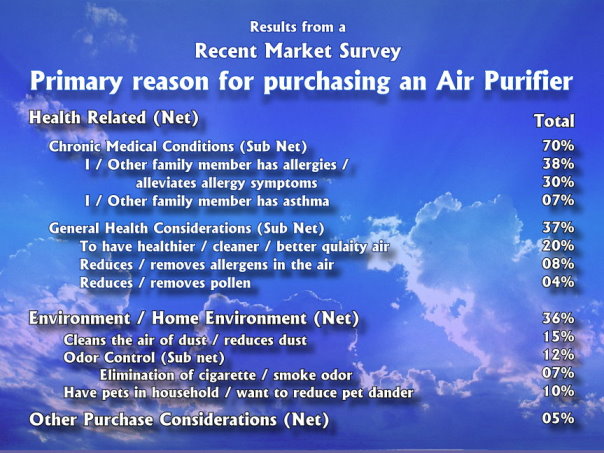
Two QUESTIONS still
remain.
1)
"Are the people who pay their money actually getting the answers to
their concerns? And,
2) is the technology they are acquiring doing the job they are
expecting?
As follows, they may well be surprised at what they are (or, really,
are NOT) getting.
Active
vs. Passive. For all the dozens -- if not hundreds -- of
devices offered to the public to do some sort of air filtering or
purifying, they all,
without exception, fall into one of only two categories, for there
are just two basic approaches to IAQ issues. The most common - because
until recently the only
approach known - has been passive.
1. Passive
technology.
|
Passive technology always
employs some form of filtration and
always requires that contaminates
find their way to the filtering device.
A
filter is to the airborne contaminate what the spider's web is to the
insect. No matter how big or how little, regardless of
the size or design, a germ or bug may fly freely about the air space
unless or until it is caught in the trap of the filter fibers or the
web. If it is small enough to slip through the fibers or strong enough
to wriggle loose, it is free to fly about again. Even if a filter were
100% effective at trapping and keeping 100% of the contaminates 100% of
the time (which it never is or can be), its
effectiveness would be limited only to those contaminates which
physically pass through the filtering mechanism, leaving all the
unfiltered air to remain contaminated. |

Does this represent the air
"purifier" you are depending upon? If so, your technology is
full of holes. |
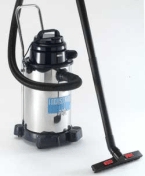
A
passive air purifier's ability to clean a room, like a vacuum
cleaner, is limited to its physical location and its ability
to move dirt toward its intake.
|
Another
analogy would be that of a vacuum cleaner in a room saturated with dust
and dirt - on the floor and carpet, the furniture, the drapes, the
bookshelves, everywhere. Giving the vacuum credit for being 100%
efficient (which it can never be) at removing dirt from any air that it
suctions, put the vacuum in the room anywhere you like, high or low,
and turn it on at maximum power. Regardless of what it does to the air
and contaminates once they enter the machine, it's
ability to clean the room is limited to its physical location and its
ability to move dirt toward its intake.
Because of its inherent design technology, even powered by a jet
engine, it will never clean the room completely. There will be wind
current eddies and dead spots, just as in a running stream, that will
harbor materials which will never see the inside of a passive air
filter. (The kind of power it would take to get all the dirt into the
vacuum would be enough to suck up the furnishings and carpet as well.
Plus, the noise would be unbearable!) |
|
Among
the so called air "purifier" manufacturers, the competition is fierce.
Some do speak of "CFM" (cubic
feet per minute),
the measured amount of air that can pass through such a system over a
given period of time. Some companies or models use a germicidal light
or other method to try to sanitize or sterilize the air which makes it
through the device. At least one make boasts an incinerator
to burn up contaminates as they pass through. But regardless
of brand, model, size, capacity, or features, the hottest area of
contention, however, is the efficiency of the filter/s
themselves, often offered in multiples or
multi-stages.
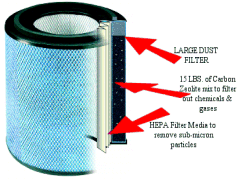 A
term often heard among air device manufacturers is that their system or
filter meets "HEPA"
standards. A
term often heard among air device manufacturers is that their system or
filter meets "HEPA"
standards.
Developed
after World War II to trap atomic dust particles, "HEPA"
stands for "High Efficiency Particulate Arrestance".
It generally means that the filter will capture 99.97% of
particulates down to those as small as .3 microns, which includes some
bacteria, fungal, and other opportunistic micro biologicals.
At
first glance, that is pretty impressive. To be sure, for all those
people who have gained some measure of relief by being able to breathe
air whose contaminates have been reduced to some degree, HEPA and
passive air purification has been a blessing. But the
results have often been inconsistent and not stable enough to be
accurately predictable from one venue to another or
from one piece of equipment to the next.
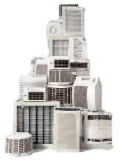 Even
among those conforming to HEPA standards there will be discrepancies
and deficiencies depending upon when the evaluation tests are run
relative to the buildup of the load in the filter itself.
Was the filtering medium fresh? Were the numbers achieved and averaged
over any particular length/s of time and filtering loads? What were
those parameters? How dirty was the air that went into the device? What
was the measurable air flow at the time of the test, and how did it
compare to later when the filter was much more full (dirtier)?
Even
among those conforming to HEPA standards there will be discrepancies
and deficiencies depending upon when the evaluation tests are run
relative to the buildup of the load in the filter itself.
Was the filtering medium fresh? Were the numbers achieved and averaged
over any particular length/s of time and filtering loads? What were
those parameters? How dirty was the air that went into the device? What
was the measurable air flow at the time of the test, and how did it
compare to later when the filter was much more full (dirtier)?
What
most have observed about other types of filters, be they vacuum bags or
oil or air filters for cars, is also true of HEPA filters. It stands to
reason that a filter works by letting air pass through its openings,
whether they be small or large (although the surrounding fibers are an
impediment). As particles are caught on the surfaces of the filter's
fibers, they bridge over the openings through which air is supposed to
pass and clog them. As those openings become clogged, the number of
remaining openings diminishes.
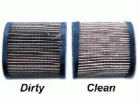 Hence,
the more that filtered particles build up on the filtering surfaces,
the less efficient will be the flow of air through the filter.
The slower the air stream through a filter, the fewer the particulates
which will be taken out of the stream flow and the less will be the
efficiency of the device. Unless a system's rating is
based upon its minimum efficiency under loaded
conditions, any filtering device will function at its best when new or
equipped with fresh filtering media and drop off (often exponentially)
as it does its job and the load increases. Hence,
the more that filtered particles build up on the filtering surfaces,
the less efficient will be the flow of air through the filter.
The slower the air stream through a filter, the fewer the particulates
which will be taken out of the stream flow and the less will be the
efficiency of the device. Unless a system's rating is
based upon its minimum efficiency under loaded
conditions, any filtering device will function at its best when new or
equipped with fresh filtering media and drop off (often exponentially)
as it does its job and the load increases.
While
diminishing filter capacity concerns are a consideration, they do not
represent the main weakness of passive technology. Nor is the issue
primarily the relative power of the air moving device (fan horsepower,
speed, blade efficiencies, etc.) The fundamental
deficiency is that the technology is utterly dependent upon
contaminates finding their way into the filter where they can be
trapped. Experience has shown that not all contaminates
cooperate in this effort.
And beyond those considerations, there
may remain questions as to the viability of pathogens and mold spores,
trapped to be sure, but which might still be able to pose a threat
where they accumulate in the filtering device or may find themselves
scattered when the filters are removed, replaced, or cleaned.
|
All
of the above having been said and factored, there is one final concern,
but it is staggering. It must be understood that not all HEPA filters
are created equal. And it must also be acknowledged that all
HEPA filters do not perform at the same level or efficiencies.
Some do better earlier into their useful lives, while others
may function not as well initially but be more consistent over their
service life. Be that as it may, as of this time in history, the HEPA
filter as a class
seems to be the best of the best as far as filters
and filtration technologies
are concerned (all of which are passive
and, consequently, limited as discussed). One huge fact remains, an
issue having to do with the sheer physics of the problem.
While
the list of particles and particle sizes filtered out by HEPA compliant
filters appears to be impressively grand (all sizes down to .3
microns), 98.5% of all particle counts are <.5
microns! As tiny as these particles are individually,
their collective mass comprises 6% by weight
of all the particles in the air. If at first glance 6% of the weight of
collective particulates may seem somewhat small, think of the massive
amount of weight and the large particle sizes one would find in a full
vacuum container bag or an air filter. Depending upon the vacuum or
filter type, three to six percent (or even more) of all the
particulates one would want cleaned from the breathing space would pass
all the way through the filter and back out again, even if the filter
device could force all the particles in the room to enter its orifice.
Then remember that it is the small particulates
(<.5 microns) which make us ill. |
Passive air purification technology, regardless of how efficient,
leaves unresolved any items or issues not passing through its system,
and, is, therefore, an inferior and aged approach if utilized alone.
|
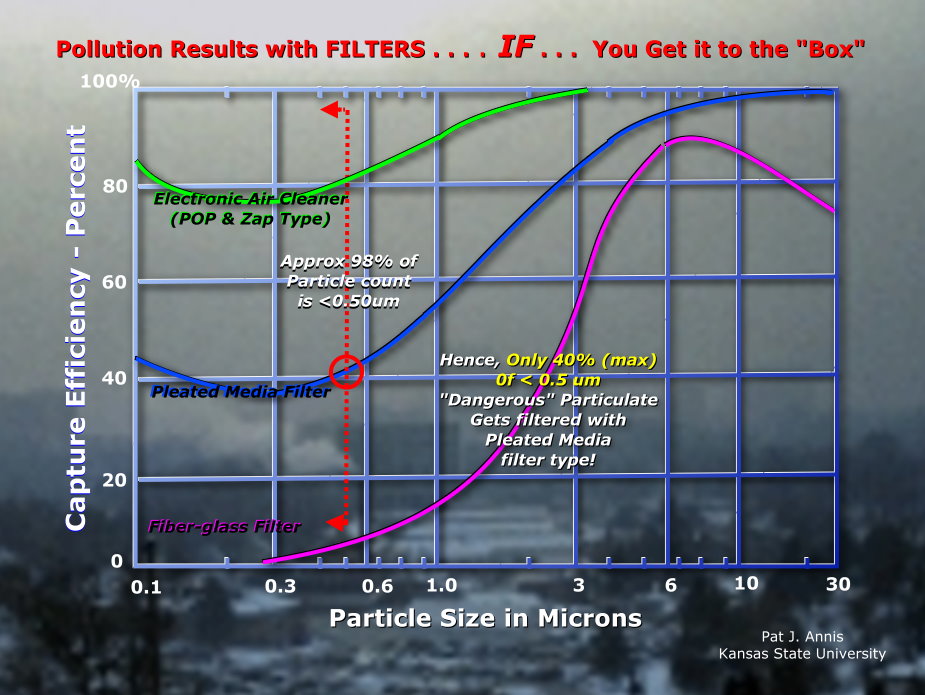 |
|
Summary
of the common problems
faced by ALL Passive Technologies |
| X |
IMPOSSIBLE
for ALL air to get TO them and THROUGH them.
|
| X |
FILTERS
and PLATES become constant source of POLLUTION,
HIGH MAINTENANCE, and COST. |
| X |
FILTERS
and PLATES have LIMITED EFFECT on VOC's, ODORS, BACTERIA, MOLD, and
MILDEW which pass through the systems. |
| X |
FILTERS
and PLATES have NO EFFECT on VOC's, ODORS, BACTERIA, MOLD, and MILDEW
on SURFACES in the room. |
| X |
Where
UV lights are used, they affect only the specific areas
onto which they directly shine. |
| X |
VENTILATING
is extremely expensive and limited in its effectiveness.
|
| X |
If
PASSIVE technology is so effective,
WHY ISN'T THE PROBLEM SOLVED? |
| 2. |
Active
technology. |
 |
|
As
designed for nature, there is virtually no such thing as "passive" air
purification.
While the natural processes for purifying water are primarily passive, outdoor
air is purified by processes which are expressly active.
Sunlight and lightning
and the effects of the wind rushing through the trees (among others)
give us our purified breathable air. The ability to do
indoors what was designed for the outdoors lies at the heart of active
(or pro-active) technology which does not wait
for contaminates to find a filter.
Instead
of a "spider's web" approach which depends upon particulates hitting
the filter media, active air purification technology is
like launching a never ending stream of billions of "microscopic
electric fly swatters" or "Pac Men" which seek out and remove from the
air whatever is floating around which would cause us respiratory
distress. It utilizes an exclusive synergistic
multi-stage combination of scientifically proven methods for finding
and dealing with the contaminates wherever they are.
a.
Stage
One -- Dual Ionization (Particulate Removal).
Stage
one is actually a combination of two steps. Two separate ion generators
put out large volumes of both positive and negative ions and introduce
them into the entire environmental space with very little noise. These opposingly
charged ions penetrate through walls, attic spaces, and rooms
throughout the building, causing air-borne particulates to flocculate
or clump together, rendering them too heavy to remain air-borne.
|
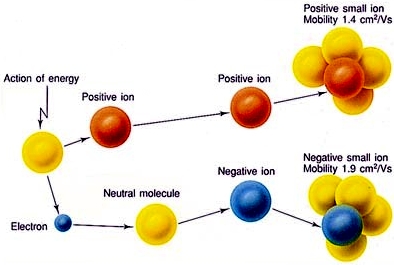 |
Although they were once small
enough to remain airborne, electrically charged ions have attracted
enough particulates together so that they must fall out of breathing
range. |
Like
aircraft too heavy for their engines or jumbo jets out of fuel, the
particulates stagger and fall to the floor, colliding, collecting, and
clumping with others on their way down. Rather than passive, this is active technology which fully sweeps and
cleans the interior air spaces and penetrates into cavity areas.
Ions also adversely affect the health of pathogens while improving the
feeling of well being among people and animals.
|

b.
Stage
Two -- Quad Oxidizing Plasmas.
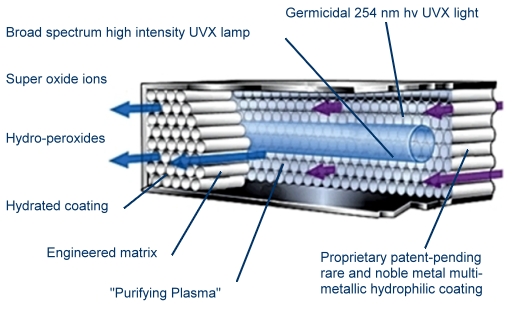
Stage
two involves the simultaneous use of another technology which
introduces a plasma of multiple, "friendly" oxidizers into the living
space.
(They are known as "friendly", for, just as in nature, whether or not
they have had the opportunity to do their assigned duties, within about
thirty minutes, they revert right back to molecules of H2O
from whence they were derived from the air in the atmosphere.)
Combining
high intensity UVX light with a specially developed rare
metal hydrophilic coating on an engineered matrix, Radiant
Catalytic Ionization™
(RCI™) reduces airborne contaminants, and
odors while creating super oxide ions and hydro-peroxides. While
active, these oxidizers also have the
potential of infiltrating behind wall cavities, and wherever they go
they strip the very hardy shells off of mold spores,
fungi, and numerous other pathogens and contaminants, killing them
outright or rendering them very susceptible to destruction.
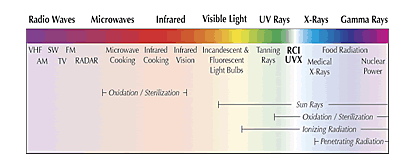
By
engineering the proper light wavelengths into the RCI™
cell, what develops is a highly effective system designed to utilize
254 nm hv germicidal UV light. Falling between visible UV light and
invisible X-Rays in the light spectrum, UVX makes use of
the same oxidation and ionizing properties of light as naturally
occurring sunlight. This technology takes advantage of
these ionizing properties and combines them with the photo catalytic
reactions of specific rare and noble metals to create Radiant Catalytic
Ionization™
(RCI™).
This innovative use of light is what makes RCI™
so effective. |
|

c.
Stage
Three -- Advanced Oxidization.
In
stage three, additional technology generates a tunable
level of naturally occurring penetrating oxidation gases which attack
the nuclei of the now exposed cells, either fully killing the
pathogenic cell, or, as in the case of mold spores, affecting the RNA
and the DNA of the spores so that they cannot reproduce.
(While science cannot agree as to whether such a spore is technically
"dead" or alive, there is agreement that neutered cells
cannot proliferate and create mold or pathogenic colonies.
Part of the problem may be that, because 200,000 or so spores can fit
on the head of a pin, we may not have a stethoscope small enough to
listen for a pulse on any of them.)
d.
Combo
Effect -- The Whole is Greater Than the Sum of its Parts.
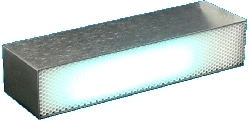
"These are
highly reactive chemical species. Hydroxyl radicals
are very strong oxidizers and will
attack all kinds of organic
materials.”
-- Daniel Blake, Dept of
Energy’s Natural Renewable Energy
Laboratory, Golden, Colorado
As
with the ions, the generated oxidizing plasmas are so efficient that
they penetrate to wherever the germs are hiding and render them
harmless. This patented triple combination of pro-active technologies
is available exclusively under the trade name of "RCI"TM, so named for "Radiant
Catalytic
Ionization",
also trademarked. RCITM has been
shown in university studies to have a kill rate as high as
six log (99.9999%) of surface laden pathogens anywhere in the air space.
|



All
materials not supplied by manufacturers or others are
Copyright
2005 - 2014 -- breathe-easier.com -- All Rights Reserved
|
 |
NEW!

Check
out the videos



An introduction to indoor air
quality issues.


B.
What Don't We Know?
--
KWIK FACTS.
The problem is worse than we realize.


C.
What Do We Need to Know?
Sorting out the info and charting
a course to follow.

D.
What are We Breathing?
Unwelcome
guests we receive every time we breathe.
2. Allergens.
The
body’s “hit list” of alien invaders.

3. Pathogens.
The
bacteria, viruses, and germs which reproduce in the human body
and
try to
stage
a
takeover.

4. Odors.
Things
have odors for a reason, but why?
Can the problem be corrected rather than merely masked or covered up?


5. Chemicals/Smoke/VOC's.
Are we
possibly drowning in a toxic soup?


6. Mold.
Is what we see dangerous?
And is what we don't see
perhaps more dangerous than what we do see?


E.
Which Technology Works the Best?
Are the technologies pretty
much equal, or is their a large disparity among them?


1. Passive Technology.
The pollution finds the solution.
(Or so we hope!)


2.
Active Technology.
The solution finds the pollution -
even where it is hiding!


a. Stage One -- Dual
Ionization (Particulate Removal)


b.
Stage Two -- Quad
Oxidizing Plasmas


c.
Stage Three -- Advanced
Oxidation


d.
Combo Effect -- The
Whole is Greater Than the Sum of its Parts.


3. Major Differences.
Things that are not the same
are not equal.


a. Literally out of this
world.
The technology which produces
"the purest air on the planet"
actually comes from
out of this world.


b. Overall Air Purity.
By what standard do
you certify the actual purity of air?

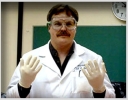
c. Too Clean to Test for Purity?
"Without dirt in the air,
we cannot tell you
how pure the air is."
Does that strike anybody as odd?


d.
Where's the Dirt?
(Where is Clara Peller
when you need her?)


e. What to do?
Anybody
can see that it’s clean except the career bureaucrats.

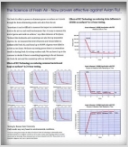
f. Where are the Germs?
Hint: One place they are not
is
"Blowin' in the Wind".


g. Filtration rates vs. Kill
rates.
In the war against pathogens,
would you like your germs
captured and contained
or killed "graveyard dead"?


h.
Odor Abatement/Removal.
The
same thing that RCITM
does to
particulates and germs it does also to smoke, dust, and sources of
odors.


F. What IAQ
issues must be considered and addressed?
Head to head comparison of the technologies - very revealing.


G.
Are there medical considerations?
Obligatory disclaimers and the practical realities of what happens when
a sick body can actually catch its breath.


H.
Are there legal and other considerations?
What happens if we just
ignore the problem or fail to investigate it fully?


I.
When is Timing an Issue?
If
the mold or other air quality problem doesn't seem to be spreading or
getting any worse, so we really have to pay it any attention?

|
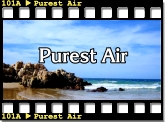













































































 A
term often heard among air device manufacturers is that their system or
filter meets "HEPA"
standards.
A
term often heard among air device manufacturers is that their system or
filter meets "HEPA"
standards. 
 Hence,
the more that filtered particles build up on the filtering surfaces,
the less efficient will be the flow of air through the filter.
The slower the air stream through a filter, the fewer the particulates
which will be taken out of the stream flow and the less will be the
efficiency of the device. Unless a system's rating is
based upon its minimum efficiency under loaded
conditions, any filtering device will function at its best when new or
equipped with fresh filtering media and drop off (often exponentially)
as it does its job and the load increases.
Hence,
the more that filtered particles build up on the filtering surfaces,
the less efficient will be the flow of air through the filter.
The slower the air stream through a filter, the fewer the particulates
which will be taken out of the stream flow and the less will be the
efficiency of the device. Unless a system's rating is
based upon its minimum efficiency under loaded
conditions, any filtering device will function at its best when new or
equipped with fresh filtering media and drop off (often exponentially)
as it does its job and the load increases.